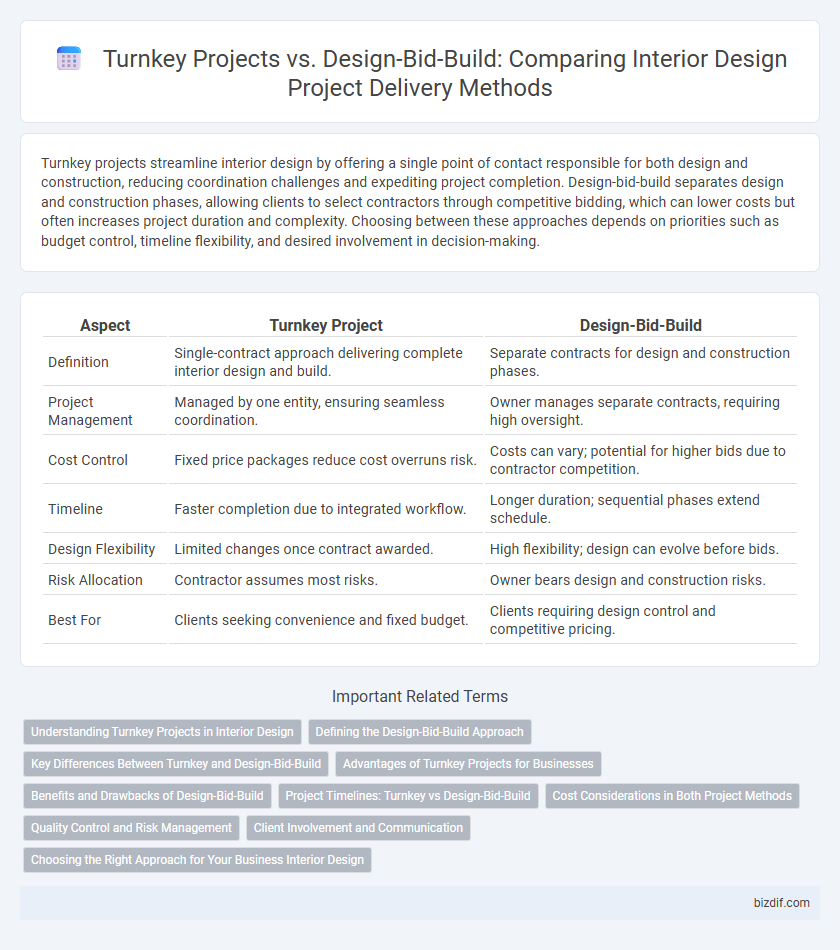Turnkey projects streamline interior design by offering a single point of contact responsible for both design and construction, reducing coordination challenges and expediting project completion. Design-bid-build separates design and construction phases, allowing clients to select contractors through competitive bidding, which can lower costs but often increases project duration and complexity. Choosing between these approaches depends on priorities such as budget control, timeline flexibility, and desired involvement in decision-making.
Table of Comparison
| Aspect | Turnkey Project | Design-Bid-Build |
|---|---|---|
| Definition | Single-contract approach delivering complete interior design and build. | Separate contracts for design and construction phases. |
| Project Management | Managed by one entity, ensuring seamless coordination. | Owner manages separate contracts, requiring high oversight. |
| Cost Control | Fixed price packages reduce cost overruns risk. | Costs can vary; potential for higher bids due to contractor competition. |
| Timeline | Faster completion due to integrated workflow. | Longer duration; sequential phases extend schedule. |
| Design Flexibility | Limited changes once contract awarded. | High flexibility; design can evolve before bids. |
| Risk Allocation | Contractor assumes most risks. | Owner bears design and construction risks. |
| Best For | Clients seeking convenience and fixed budget. | Clients requiring design control and competitive pricing. |
Understanding Turnkey Projects in Interior Design
Turnkey projects in interior design streamline the process by offering a single point of responsibility from initial concept to project completion, ensuring cohesive execution and time efficiency. Unlike design-bid-build, where design and construction phases are separate and involve multiple contracts, turnkey projects integrate these phases under one contract, reducing risks of miscommunication and delays. This approach is particularly beneficial for commercial interior projects requiring coordinated timelines and budget control.
Defining the Design-Bid-Build Approach
The Design-Bid-Build approach involves a sequential process where the interior design is fully developed before contractors bid on the construction phase, ensuring clear project specifications and competitive pricing. This method separates design and construction responsibilities, providing clients with defined roles and fixed costs. It is ideal for projects requiring precise design control and transparent budgeting within interior design workflows.
Key Differences Between Turnkey and Design-Bid-Build
Turnkey projects provide a single point of responsibility by combining design and construction under one contract, enabling streamlined communication and faster project completion in interior design. Design-bid-build separates the design and construction phases, requiring clients to manage multiple contracts, which can lead to longer timelines and potential coordination challenges. Key differences include risk allocation, project control, and cost predictability, with turnkey offering more integrated management and design-bid-build allowing greater client involvement in each phase.
Advantages of Turnkey Projects for Businesses
Turnkey projects streamline the entire interior design process by providing a single point of accountability, reducing communication gaps and project delays. Businesses benefit from faster project completion and cost certainty, as all design, procurement, and construction services are managed under one contract. This integrated approach minimizes risk and enhances quality control, ensuring a cohesive and efficient delivery tailored to business needs.
Benefits and Drawbacks of Design-Bid-Build
Design-bid-build in interior design offers clear project segmentation by separating design and construction phases, ensuring competitive bidding that can lower costs. However, this method often leads to longer timelines and potential communication gaps, increasing the risk of design discrepancies and budget overruns. Despite these challenges, its structured approach provides clients with well-defined contracts and accountability from both designers and contractors.
Project Timelines: Turnkey vs Design-Bid-Build
Turnkey projects typically offer faster completion times by consolidating design and construction under a single contract, streamlining decision-making and reducing delays. Design-bid-build separates design and construction phases, often resulting in longer timelines due to sequential workflows and potential bid review periods. Interior design firms engaging in turnkey contracts can better meet tight deadlines compared to those relying on traditional design-bid-build methods.
Cost Considerations in Both Project Methods
Turnkey projects often provide a fixed price, reducing the risk of cost overruns through a single contract that covers design and construction, ideal for budgets with strict limits. Design-bid-build separates design and construction contracts, potentially leading to lower initial bids but higher costs due to change orders and coordination challenges. Careful cost control in turnkey projects contrasts with the competitive bidding approach of design-bid-build, impacting overall budget predictability in interior design projects.
Quality Control and Risk Management
Turnkey projects centralize quality control by assigning a single contractor responsibility for design and construction, reducing communication gaps and enabling streamlined risk management through unified oversight. Design-bid-build separates design and construction phases, increasing potential quality inconsistencies and elevating risk due to fragmented accountability and contractor coordination. Effective risk management in design-bid-build requires detailed specifications and rigorous contractor evaluation to mitigate quality issues inherent in the segmented workflow.
Client Involvement and Communication
Turnkey projects minimize client involvement by delivering a fully completed interior design solution, streamlining communication through a single point of contact. Design-bid-build requires active client participation during each phase, fostering direct communication between the client, designer, and contractors. Efficient communication channels in turnkey projects reduce decision-making time, while design-bid-build offers greater client control but demands more frequent coordination.
Choosing the Right Approach for Your Business Interior Design
Turnkey projects offer a streamlined solution by combining design and construction into a single contract, minimizing coordination efforts and shortening project timelines for business interior design. Design-bid-build separates the design and construction phases, providing more control and competitive pricing but requiring greater management oversight and potentially longer schedules. Selecting the right approach depends on the business's priorities for control, budget, and project delivery speed in the interior design process.
Turnkey project vs Design-bid-build Infographic

 bizdif.com
bizdif.com